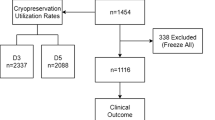Abstract
Purpose
To determine if blastocyst transfer increases the ongoing and cumulative pregnancy rates, compared with day 3 embryo transfer, in women of all ages when at least 4 zygotes are obtained.
Methods
Prospective study including patients undergoing a first IVF/ICSI treatment and assigned to cleavage stage (n = 46) or blastocyst (n = 58) embryo transfer. Supernumerary embryos were vitrified and patients failing to achieve an ongoing pregnancy after fresh embryo transfer would go through cryopreserved cycles. The main outcome measure was the ongoing pregnancy rate after the fresh IVF/ICSI transfer and the cumulative ongoing pregnancy rate. Results were also analyzed according to age (under 35 and 35 or older).
Results
A majority of patients (96.6 %) had a blastocyst transfer when at least 4 zygotes were obtained. The ongoing pregnancy rate was significantly higher in the day-5 group compared with the day-3 group (43.1 % vs. 24 %, p = 0.041). The cumulative ongoing pregnancy rate was higher (but not significantly) with blastocyst than with cleavage stage embryos (56.8 % vs. 43.4 %, p = 0.174). When analysed by age, patients 35 or older showed significantly higher ongoing pregnancy rate (48.4 % vs. 19.3 %, p = 0.016) and cumulative ongoing pregnancy rate (58 % vs. 25.8 %, p = 0.01) in the day-5 group compared to the day-3 group, while no such differences were observed in women under 35.
Conclusions
Blastocyst transfer can be suggested whenever there are at least 4 zygotes. While there are no differences in women under 35, the benefit of this option over cleavage stage transfer could be significant in women 35 or older.
Similar content being viewed by others
References
Glujovsky D, Blake D, Bardach A, Farquhar C. Cleavage stage versus blastocyst stage embryo transfer in assisted reproductive technology (Review). Cochrane Database of Syst Rev. 2012. doi:10.1002/1465 1858.CD002118.pub4.
Papanikolaou E, Kolibianakis E, Tournaye H, Venetis C, Fraterni H, Tarlatzis B, et al. Live birth rates after transfer of equal number of blastocysts or cleavage-stage embryos in IVF. A systematic review and meta-analysis. Hum Reprod. 2008;23:91–9.
Rienzi I, Ubaldi F, Iacobelli M, Ferrero S, Minasi MG, Martinez F, et al. Day 3 embryo transfer with combined evaluation at the pronuclear and cleavage stages compares favourably with day 5 blastocyst transfer. Hum Reprod. 2002;17:1852–5.
Guerif F, Lemseffer M, Bidault R, Gasnier O, Saussereau MH, Cadoret V, et al. Single day 2 embryo versus blastocyst-stage transfer: a prospective study integrating fresh and frozen embryo transfers. Hum Reprod. 2009;24:1051–8.
Brugnon F, Bouraoui Z, Ouchchane L, Gremeau AS, Peikrishvili R, Pouly JL, Janny L. Cumulative pregnancy rates after single cleavage-stage versus blastocyst-stage embryo transfer: a randomized and prospective study. Hum Reprod. 2010; i60-1.
Emiliani S, Delbaere A, Vannin AS, Biramane J, Verdoodt M, Englert Y, et al. Similar delivery rates in a selected group of patients, for day 2 and day5 embryos both cultured in sequential medium: arandomized study. Hum Reprod. 2003;18:2145–50.
Cobo A, de los Santos MJ, Castelló D, Gámiz P, Campos P, Remohí J. Outcomes of vitrified early cleavage-stage and blastocyst-stage embryos in a cryopreservation program: evaluation of 3150 warming cycles. Fertil Steril. 2012;98:1138–45.
Van der Auwera I, Debrock S, Spiessens C, Afschrift H, Bakelants E, Meuleman C, et al. A prospective randomized study: day 2 versus day 5 embryo transfer. Hum Reprod. 2002;17:1507–12.
Papanikolaou E, D’haeseleer E, Verheyen G, Van de Velde H, Camus M, Van Steirteghem A, et al. Live birth rate is significantly higher after blastocyst transfer when at least four embryos are available on day 3 of embryo culture. A randomized prospective study. Hum Reprod. 2005;20:3198–203.
Coskun S, Hollanders J, Al-Hassan S, Al Sufyan H, Al-Mayman H, Jaroudi K. Day 5 versus day 3 embryo transfer: a controlled randomized trial. Hum Reprod. 2000;15:1947–52.
ASEBIR. Clinical Embryology Papers: ASEBIR criteria for the morphological evaluation of human oocytes, early embryos and blastocysts. www.asebir.com
Gardner DK, Schoolcraft WB. In vitro culture of human blastocysts. In: Jansen R, Mortimer D, editors. Towards reproductive certainty: Infertility and genetics beyond 1999. The plenary proceedings the 11th World Congress on In Vitro Fertilization and Humarn Reproductive Genetics. New York: Parthenon Pub. Group; 1999. p. 378–88.
Gardner DK, Schoolcraft WB, Wagley L, Schlenker T, Stevens J, Hesla J. A prospective randomized trial of blastocyst culture and transfer in in-vitro fertilization. Hum Reprod. 1998;13:3434–40.
Janny L, Menezo YJR. Maternal age effect on early human embryonic development and blastocyst formation. Mol Reprod Dev. 1996;45:31–7.
Pantos K, Athanasiou V, Stefanidis K, Stavrou D, Vaxevanoglou T, Chronopoulou M. Influence of advanced age on the blastocyst development rate and pregnancy rate in assisted reproductive technology. Fertil Steril. 1999;71:1144–6.
Beesley R, Robinson R, Propst A, Arthur N, Retzloff M. Impact of day 3 or day 5 embryo transfer on pregnancy rates and multiple gestations. Fertil Steril. 2009;91:1717–20.
Staessen C, Plateau P, Van Assche E, Miciels A, Torunaye H, Camus M, et al. Comparison of blastocyst transfer with or without preimplantation genetic diagnosis for aneuploidy screening in couples with advanced maternal age: a prospective randomized controlled trial. Hum Reprod. 2004;19:2849–58.
Conflict of interest
The authors declare that they have no conflict of interest.
Author information
Authors and Affiliations
Corresponding author
Additional information
Capsule The transfer of blastocysts significantly improve the clinical and ongoing pregnancy rate as well as thecumulative pregnancy rate in women 35 years or older.
Rights and permissions
About this article
Cite this article
Fernández-Shaw, S., Cercas, R., Braña, C. et al. Ongoing and cumulative pregnancy rate after cleavage-stage versus blastocyst-stage embryo transfer using vitrification for cryopreservation: Impact of age on the results. J Assist Reprod Genet 32, 177–184 (2015). https://doi.org/10.1007/s10815-014-0387-9
Received:
Accepted:
Published:
Issue Date:
DOI: https://doi.org/10.1007/s10815-014-0387-9




